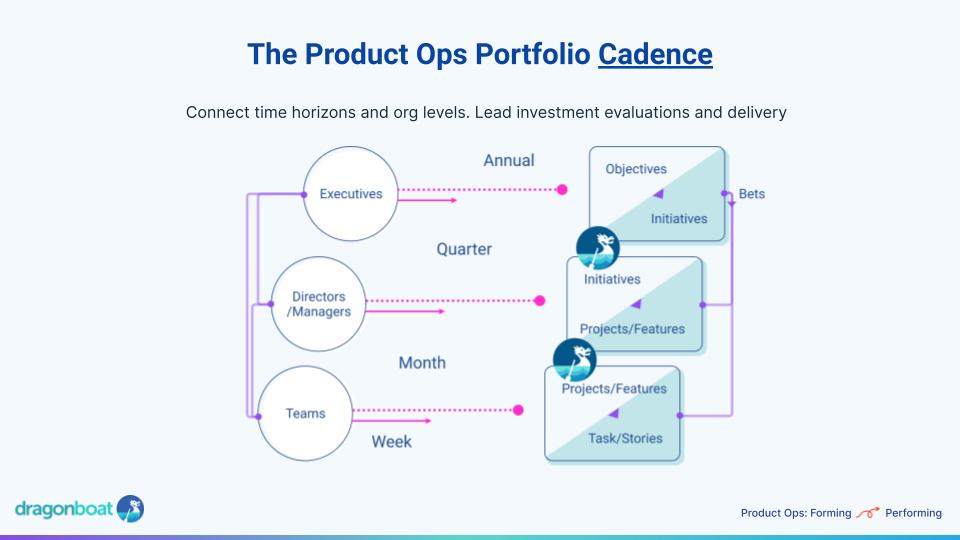Congratulations on building your product operations team! Great product operations can become the backbone of a successful product organization. However, in order to drive outcomes as much as possible, they need to be done properly from day one. This post is a short and practical outline based on Dragonboat CEO & Founder Becky Flint’s session at the 2022 PLA Product Ops Festival where she outlines how to guarantee product operations effectiveness from start to finish.
Want to see the full session? Get access to the recording and downloadable slides below.
From Forming to Performing
The 4 Stages of Building Early Product Operations
Back in the days, before it was even called product operations, Becky was one of the first to build out the function at PayPal when the whole company fit in one room before growing to fill dozens and then hundreds.
In the process of scaling and building, that’s when Becky began to notice the pattern that took product operations effectiveness from forming to performing.
Product operations first begins as the “golden thread” or “connector” of a business with 4 stages.
- Forming: Identifying a problem, getting buy-in
- Storming: Surveying and assessing the problem
- Norming: Supporting product managers and standardizing processes
- Performing: Creating a source of truth and building context and communication

The idea here is creating a connected state and building out a recognized path.
In the forming state, a product operations manager’s focus should be on getting buy-in. As a new addition to the product team, you want to build confidence in the forming stage among team members. They want to know that you can create solutions for chaotic problems.
In the storming state, a quick tip is deploying a survey to product managers and all stakeholders. This will allow you to figure out what’s blocking them and how to help them be effective.
Then as a part of the norming state you want to define a plan and begin to implement standardization so that you can reach peak performance via a source-of-truth.
Managing the Inevitable Product Operations Stall
Much like how in agile, scrum masters will experience a stall, it is normal for product operations effectiveness to hit a plateau as well. Albeit stressful, this can be an indicator that your ready to transition product operations from 1.0 to 2.0.

What does that mean?
Product Operations 1.0
Earlier in the post, we described product operations as the glue or “connector” of product. Product organizations needed strategy to grow, and that depends on data and a vision product operations provides to connect everything.
You can expect product operations 1.0 to deliver:
- Direction through clear vision
- Research, data, and facts to drive decision making
- A balanced strategy around principles #1 and #2
At a certain point, product operations effectiveness will hit a cap where being the glue is no longer sufficient to support and enable growth. That’s why we call the first phase of product operations version 1.0.
Product Operations 2.0
Where product operations 1.0 is the “connector”, product operations 2.0 is the “force multiplier”.
When product operations enters the 2.0 stage, this is where the “operations” part of “product operations” really comes into play.
And this is where product organizations will get solutions to long standing questions like:
- How do we build work?
- What will make execution happen?
- How can we create company alignment?
The need a product organization will have when product operations 2.0 enters the picture is around organizational design and development. Be sure not to rush into this stage.
Before you consider elevating your product ops to 2.0, you need to first ask yourself if prodops 1.0 delivered on what it needed to? Do you feel that prodops has helped the team?
When you hire to support growth not to deal with chaos then you’re truly ready to grow.
– Becky Flint, Dragonboat CEO & Founder
When your team is ready, you can expect product operations 2.0 to deliver:
- Well-formatted and functioning teams
- A developed work breakdown hierarchy
- Structure across the whole organization around principles #1 & #2
For more, check out Becky’s product operations roadmap to success.
Transforming Product Operations Effectiveness From Version 1.0 to 2.0
Remember that what got you here won’t get you there.
As the glue, product ops 1.0 was about providing clear data & a vision to execute strategy Product ops 2.0 is the force multiplier. They figure out how to build work & strategy to drive alignment across the board.
– Becky Flint, Dragonboat CEO & Founder
How can product operations make the transition from version 1.0 to version 2.0?
That’s where product portfolio management comes in. Product portfolio management spans from the structure to the cadence and the tools. Let’s dive in.
Structure
One of the most frequently asked questions surrounding product operations is “How do you structure product operations?” And unfortunately, the answer is “it depends”.

When a team is small (3-10 product managers), your organization requires a centralized team to build best practices and fill the needed miscellaneous roles.
When a team grows a bit bigger (10-20 product managers), different teams operate differently, so centralized teams are no longer flexible enough to drive teams. That’s where the embedded model comes into play. This might include 2-3 pods per every product operations manager and specialty teams.
Lastly, when your organization grows to house big teams (20+ product managers), they will require support. Provide this support with an effective operating system. This will double down on embedded teams that align to business units or the product line.
Cadence
Equally as important as the structure, the portfolio cadence allows product organizations to work effectively.

A good product operations cadence will operate on 3 horizons. A 3-time-horizons cadence accounts for the long-term, mid-term, and near-term goals.
This creates strategic alignment between the agile team that works in sprints, the executive team that works in annual and quarterly goals, and the functional leaders who create milestones in between.
The 3-time-horizon cadence ensures product operations effectiveness as you transition from product operations 1.0 to product operations 2.0.
Tooling
Every product manager manages between $1-5 million worth of engineering resources. And as one of the most leveraged roles, product ops will end up managing $20-30 million resources.
That’s why an effective force multiplier needs to understand the portfolio cadence as well as the right management collaboration tools to organize data from the ground up to the big-picture view.
Tools heavily influence how you work. The right tool will allow you to tie strategy to operations and connect the team together to drive their company forward.
A portfolio tool like Dragonboat is built to support the way product operations need to work. With so many fuzzy pieces that require constant evaluation, an outcome-focused tool that allows you to compare scenarios, connect initiatives to OKRs, and get real-time updates will be a game-changer in accelerating product operations effectiveness.




